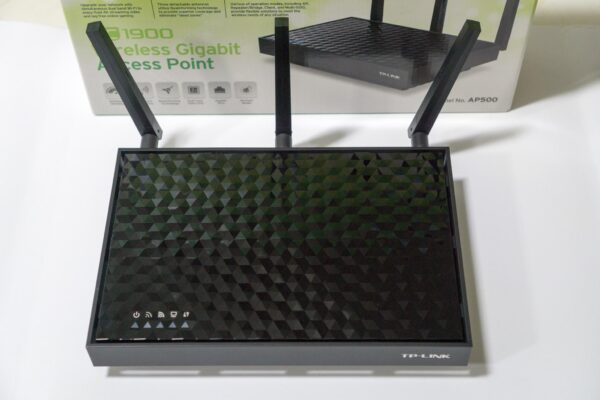
For the most part, most people are happy with a single all-in-one wireless broadband router for their home. Some of us, however, recognise the need for range extenders or dedicated wireless access points. There aren’t as many of these devices in the market, so I was quite happy to come across this TP-Link AP500, a dedicated AC1900 wireless access point.
I’ve been using pfSense as my main broadband router for a long time. Instead of building Wi-FI into the same devices, I’ve been using wireless broadband routers configured in bridge mode or wireless access point mode, the terminology varies depending on brand.
It had always seemed overkill, and perhaps even wasteful, to use a full-fledged wireless broadband router for my simple purpose. All the fancy features offered by the router become unavailable once they are configured in bridging mode. A simple, dedicated, wireless access point would be all I need. (Unfortunately, dedicated wireless access points don’t necessarily cost less than all-in-one wireless broadband routers.)
The TP-Link AP500 is a relatively straightforward device. It does have a couple of operating modes, which I’ll explain a little later. On the Wi-FI side, the AP500 is a dual band device capable of 600 Mbps on the 2.4 GHz band and 1,300 Mbps on the 5 GHz band, qualifying it as AC1900 speed. It supports beamforming technology, and long range capability with 700 mW high power amplifiers.
Physically, this looks like your typical desktop-style wireless broadband router. It has a glossy top, with some geometric pattern set on it, and a couple of essential LED status indicators at one corner.
On the back, there is just one RJ45 Ethernet port for connecting to an existing wired network. The AP500 can’t be used to connected multiple wired devices, so you’ll have to use the other LAN ports on your existing router, or get another network switch, if there more wired devices you need to connect up.
You’ll also find the DC input port, a physical on-off button, a LED on/off button, a WPS button and a recessed reset button on the back. There are no extra features like USB ports on the AP500.
There are three external antennas on the AP500 which you can orientate to suit your installation needs. The AP500 can either sit flat as pictured above, or stand on its side using a clip on stand provided, if you prefer. The standing position will reduce table space needed for the AP500.
The AP500 can operate in several modes:
- Access Point mode (default): In this mode, the AP500 extends an existing wired network to the Wi-FI network it creates. Essentially, the AP500 bridges its wired Ethernet to the Wi-FI network.
- Repeater/Bridge mode: This is often known as a range extender mode. The AP500 connects to an existing Wi-Fi network, and repeats on new Wi-Fi networks it creates.
- Client mode: This mode is to enable a wired-only device, connected to the AP500’s wired Ethernet port, to access an existing Wi-Fi network.
- Multi-SSID mode: This is a really nice feature. It’s similar to Access Point mode, but you can create up to four SSIDs on each of the 2.4 GHz and 5 GHz band, and map each SSID to a different VLAN on the existing wired network.
I was particularly interested in Multi-SSID mode. This mode allows to divide your Wi-Fi into multiple networks, so that you can separate out guests, for example, to a different VLAN from your regular network traffic. You would need a router that can handle VLAN trunking though.
Unfortunately, Multi-SSID doesn’t seem to quite work as documented. On the AP500, VLAN 1 is untagged. This is the issue. The problem is that while VLAN 1 works, other SSIDs mapped to other VLANs don’t work.
For example, I tried to map VLAN 10 to the GUEST SSID. Traffic arriving on the AP500’s wired Ethernet port with VLAN 10 tag will get transmitted on the GUEST SSID. However, traffic received by the AP500 on the GUEST SSID exits the wired Ethernet port untagged. It should have been VLAN 10 tagged.
I’ve opened a support ticket with TP-Link, but have not received a resolution thus far. It seems this is such a basic use case (when one uses Multi-SSID at all) that either TP-Link hasn’t really tested this themselves, or the documentation is so wrong that not only have I misunderstood its configuration, but also their support channel isn’t able to easily resolve the issue.
There are a bunch of settings you can tinker around with the Wi-Fi configuration. In particular, you can configure WPA2 AES, and disallow the slightly older WPA completely. Some other devices only support WPA/WP2 together.
In the box, the TP-Link AP500 comes with a power adapter, a stand for positioning the device vertically, three external antennas and a RJ45 UTP Ethernet cable.
The TP-Link AP500 retails for about S$167, depending on seller.
Conclusion
The TP-Link AP500 looks to be a capable AC1900 wireless access point. The Multi-SSID feature is nice, but doesn’t quite seem to work.
Pros:
- Simple, dedicated wireless access point
- Fast AC1900 speeds
- Can work in repeater/bridge mode, client mode and multi-SSID mode
- Good range with 700 mW high power amplifiers
- Can disable WPA while using WPA2 AES.
Cons:
- Multi-SSID mode doesn’t seem to work
